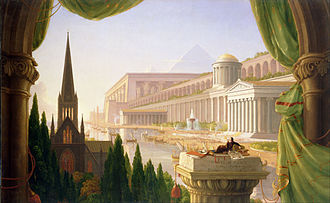
Back تاريخ العمارة Arabic Historia de l'arquiteutura AST Història de l'arquitectura Catalan مێژووی نژیاروانی CKB Dějiny architektury Czech Hanes pensaernïaeth Welsh Architekturgeschichte German Ιστορία της αρχιτεκτονικής Greek Historio de arkitekturo Esperanto Historia de la arquitectura Spanish

| History of art |
|---|
The history of architecture traces the changes in architecture through various traditions, regions, overarching stylistic trends, and dates. The beginnings of all these traditions is thought to be humans satisfying the very basic need of shelter and protection.[1] The term "architecture" generally refers to buildings, but in its essence is much broader, including fields we now consider specialized forms of practice, such as urbanism, civil engineering, naval, military,[2] and landscape architecture.
Trends in architecture were influenced, among other factors, by technological innovations, particularly in the 19th, 20th and 21st centuries. The improvement and/or use of steel, cast iron, tile, reinforced concrete, and glass helped for example Art Nouveau appear and made Beaux Arts more grandiose.[3]
- ^ Ching, Francis, D.K. and Eckler, James F. Introduction to Architecture. 2013. John Wiley & Sons. p13
- ^ Architecture. Def. 1. Oxford English Dictionary Second Edition on CD-ROM (v. 4.0) Oxford University Press 2009
- ^ Virginia McLeod, Belle Place, Sarah Kramer, Milena Harrison-Gray, and Cristopher Lacy (2019). HOUSES - Extraordinary Living. Phaidon. p. 9. ISBN 978-0-7148-7809-6.
{{cite book}}: CS1 maint: multiple names: authors list (link)
© MMXXIII Rich X Search. We shall prevail. All rights reserved. Rich X Search